Rajasthan, the energetic desert territory of India, goes through a noteworthy change during the rainstorm season. Rajasthan, renowned for its scorching heat and arid landscapes, eagerly awaits the monsoons, which provide respite from the scorching sun and an enchanting display of nature’s grandeur. Because it rejuvenates the land, replenishes water sources, and sets the stage for a one-of-a-kind experience of Rajasthan’s natural beauty and cultural vibrancy, the monsoon season is very important to the region.
While Rajasthan is regularly connected with a blistering and dry environment, the storm season brings a much needed development. The monsoons bring with them a change in weather patterns, bringing rain and cooler temperatures. The parched fields, tough slopes, and brilliant sand hills of Rajasthan change into a lavish green scene, overflowing with life and essentialness. Because it reveals a different aspect of Rajasthan’s beauty, this annual event captivates both locals and tourists.
Timing and Duration of Monsoon in Rajasthan
In Rajasthan, the monsoon season’s timing and duration have a significant impact on the climate, agriculture, and overall experience during this time. In Rajasthan, the monsoon typically follows a particular pattern, with distinct onset and withdrawal dates and varying durations across the state.
After a scorching summer, the beginning of the monsoon is eagerly anticipated in Rajasthan. Around the middle of June, the monsoon typically arrives in Rajasthan’s southwest, near the state of Gujarat. It then moves further north and east, eventually encompassing the entire state within a few weeks.
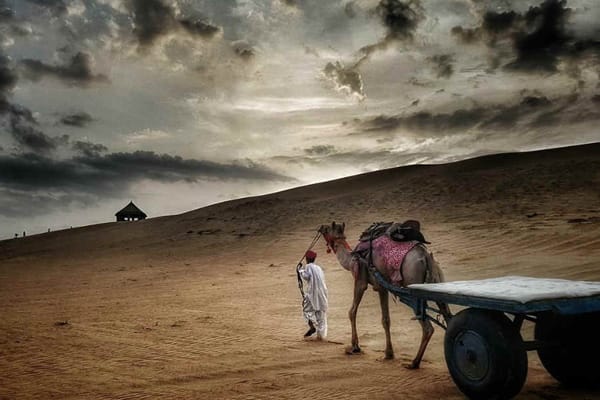
The monsoon’s departure from Rajasthan typically begins in September. It begins with a retreat from the state’s western parts and gradually moves toward the state’s eastern parts. The monsoon leaves Rajasthan completely by the end of September or early October, preparing the way for the post-monsoon season.
The term of the rainstorm season in Rajasthan shifts relying upon the area. The southwestern pieces of the state, like Udaipur and Mount Abu, get the primary showers and have a more extended storm period, frequently going on for around 4-5 months. There is a monsoon season in the central and eastern regions, including Jaipur and Ajmer. It typically lasts about two to three months. The northwestern desert regions, as Jaisalmer and Bikaner, get generally lesser precipitation and have a more limited rainstorm term, going on for around 1-2 months.
The power of rainstorm precipitation likewise changes across various pieces of Rajasthan. When compared to the western and northwestern regions, the southern and southeastern regions typically receive more rainfall. The Aravalli Reach, extending across the state, goes about as a hindrance and impacts the circulation of precipitation, bringing about varieties in the storm designs.
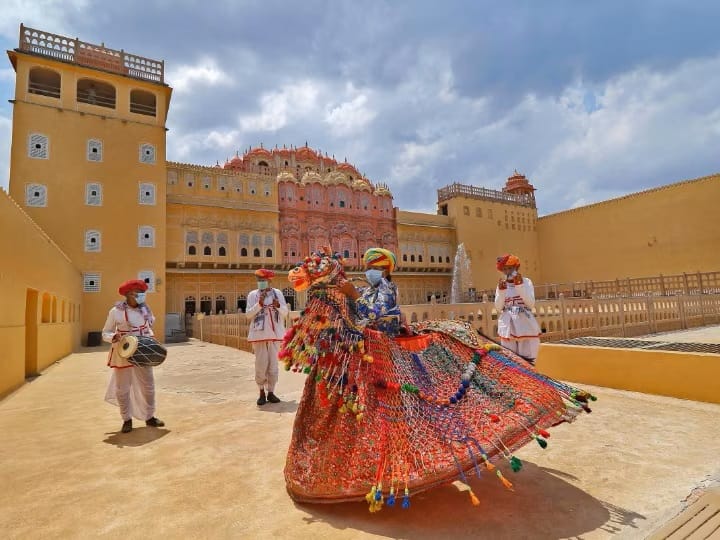
During the storm season, Rajasthan encounters discontinuous precipitation, portrayed by times of weighty showers mixed with bright spans. The force of precipitation can be critical, prompting limited flooding in low-lying regions and impermanent disturbances in day to day existence. The precipitation assumes an essential part in re-energizing water bodies, renewing groundwater levels, and supporting horticultural exercises in the district.
It is important to note that although the timing and duration of the monsoon in Rajasthan typically follow these patterns, weather changes and other factors can occasionally cause deviations. As a result, accurate and specific information regarding Rajasthan’s monsoon season can be found in up-to-date weather forecasts and regional climate data.
Natural Beauty and Ecotourism
In Rajasthan, the monsoon season brings out a stunning display of natural beauty, bringing life to the arid landscapes and providing a one-of-a-kind opportunity for ecotourism. The restoration of greenery, combined with the development of water bodies, makes a pleasant setting that tempts nature lovers and experience searchers the same.
Verdant Greenery: A sight to behold is the transformation of Rajasthan’s barren lands into a carpet of lush greenery. The state’s vibrant vegetation has sprouted as a result of the soil being nourished by the monsoon showers. A stunning contrast against the otherwise arid backdrop is created when a variety of wildflowers, grasses, and shrubs cover the hills, valleys, and plains.
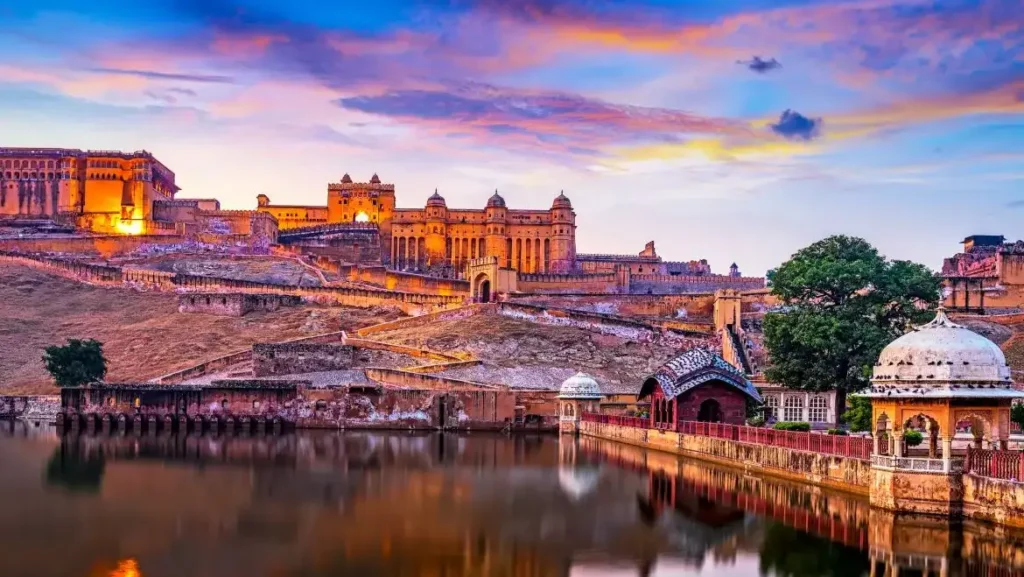
Lakes and Cascades: Lakes, reservoirs, and rivers see a significant rise in water levels during the monsoon season. Great lakes, for example, Lake Pichola in Udaipur and Sambhar Lake close to Jaipur wake up, mirroring the shady skies and encompassing plant life. Although there aren’t many waterfalls in Rajasthan, there are some, like the Chitrakoot Waterfall in the Bundi district. As they flow down, these cascades become a breathtaking sight, adding a sense of peace and beauty to the landscape.
National Parks and Wildlife Refuges: During the monsoon season, several wildlife sanctuaries and national parks in Rajasthan thrive. In Ranthambore National Park, which is famous for its tiger population, there is a lot of greenery, so wildlife lovers can see a lot of animals and birds in their natural habitats at this time. Keoladeo Ghana Public Park in Bharatpur is eminent for its avian variety, drawing in transitory birds during the storm season.
Bird Watching: The rainstorm season is a heaven for bird sweethearts in Rajasthan. Numerous resident and migratory bird species populate the lakes, wetlands, and marshes. Species like peafowls, herons, kingfishers, egrets, and cranes, among others, can be observed while birdwatchers listen to their melodious calls and vibrant feathers. The Keoladeo Ghana Public Park is especially known for its uncommon birding open doors.
Fauna and Flora of the Desert: During the monsoon, even Rajasthan’s arid desert regions undergo a transformation. The Thar Desert, otherwise called the Incomparable Indian Desert, witnesses a peculiarity known as “Desert Sprout.” Desert plants and wildflowers blossom as a result of the monsoon rains awakening dormant seeds. In contrast to the golden sands, the desert becomes adorned with vibrant blooms, creating an eerie scene.
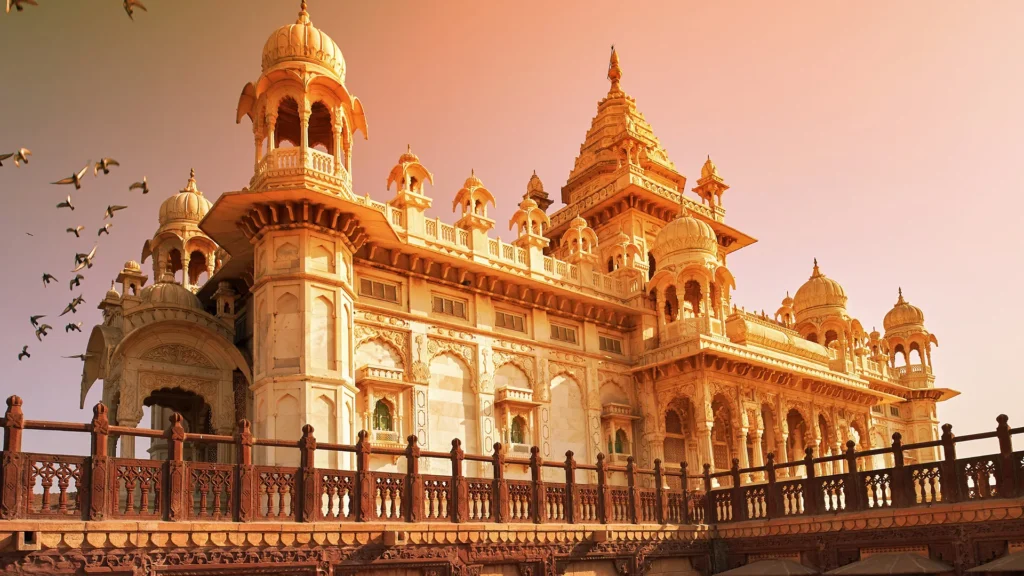
Adventure Trips and Nature Treks: Rajasthan’s monsoon season is a great time to go on nature hikes and other adventurous activities. The charming climate and beautiful scenes make it an optimal time for climbing, traveling, and investigating the tough landscapes. Adventurers can take part in activities like camping, off-roading, and zip lining while taking in the tranquility and natural beauty of the area.
In Rajasthan, the monsoon season reveals a side of the state that is frequently overlooked. It demonstrates the adaptability of life in arid environments and the resilience of nature. Whether it’s seeing the dynamic greenery, partaking in the serenity of lakes and cascades, or setting out on exciting undertakings, Rajasthan’s normal magnificence during the rainstorm season has a permanent effect on the people who decide to investigate its charming scenes.
Places to Visit During Monsoon
Rajasthan has a lot of beautiful scenic locations that come to life during the monsoon season. During the monsoon, these are some places to visit in Rajasthan:
Udaipur: During the monsoon season, Udaipur, also known as the “City of Lakes,” is a must-see destination. The picturesque lakes of Fateh Sagar and Pichola are at their most charming when they are surrounded by palaces and lush green hills. At the City Palace complex, take in the mesmerizing sound and light show, take a boat ride on the lakes, and explore the stunning City Palace.
Mount Abu: As the main slope station in Rajasthan, Mount Abu encounters a cool and wonderful environment during the rainstorm season. The tranquil Dilwara Jain Temples, cascading waterfalls like those at Honeymoon Point and Nakki Lake, and the lush green landscapes make it an ideal getaway. Enjoy boating on Nakki Lake, going to Sunset Point, and taking nature walks.

Jaipur: The Pink City of Jaipur flaunts a few attractions that merit investigating during the rainstorm season. The great Amer Post, Nahargarh Stronghold, and Jaigarh Post offer amazing perspectives on the downpour washed city. Explore the vibrant markets of Jaipur for a delightful shopping experience and take in architectural wonders like Hawa Mahal and Jal Mahal.
Jaisalmer: Jaisalmer has its own charm during the monsoon season despite being in the Thar Desert. A mesmerizing background is provided by the magnificent Jaisalmer Fort and golden sand dunes. In the stark beauty of the desert, you can take camel safaris, see folk performances, and experience the magic of the monsoon.
Keoladeo Ghana National Park: During the monsoon, this well-known bird sanctuary in Bharatpur becomes a haven for birdwatchers. In the midst of the lush vegetation and wetlands, take in the variety of avian species, including migratory birds. Take a guided tour or rent a bicycle to explore the park and capture memorable moments with your camera.
Bundi: During the monsoon season, Bundi offers a tranquil getaway with its charming stepwells, ancient forts, and palaces. The pleasant Taragarh Stronghold, the unpredictably cut stepwells like Raniji ki Baori, and the tranquil Nawal Sagar Lake are a portion of the features. Admire the stunning blue houses as you wander the old town’s narrow streets.

Chittorgarh: During the monsoon, Chittorgarh, steeped in history and aristocracy, reveals its splendor. With its palaces, temples, and stunning reservoirs, the imposing Chittorgarh Fort is a reminder of the city’s glorious past. For panoramic views of the city, go to the Kirti Stambh (Tower of Fame) and Vijay Stambh (Victory Tower).
These are just a few of the many destinations in Rajasthan that can be visited during the monsoon season. Every location offers a one of a kind mix of history, culture, and regular magnificence, giving a noteworthy encounter in the midst of the reviving storm showers.
Festivals and Cultural Celebrations
During the rainstorm season, Rajasthan wakes up with energetic celebrations and social festivals that feature the rich legacy and customs of the state. Here are a few remarkable celebrations and far-reaching developments to encounter in Rajasthan during this time:
Teej: Teej is quite possibly of the main celebration commended during the rainstorm season in Rajasthan. It symbolizes the onset of rain and the rebirth of life and is dedicated to the goddess Parvati. Women participate in processions, dances, and music performances, don colorful traditional attire, and apply intricate henna designs to their hands. Teej fairs are coordinated in different urban communities, offering a brief look into Rajasthan’s social event.
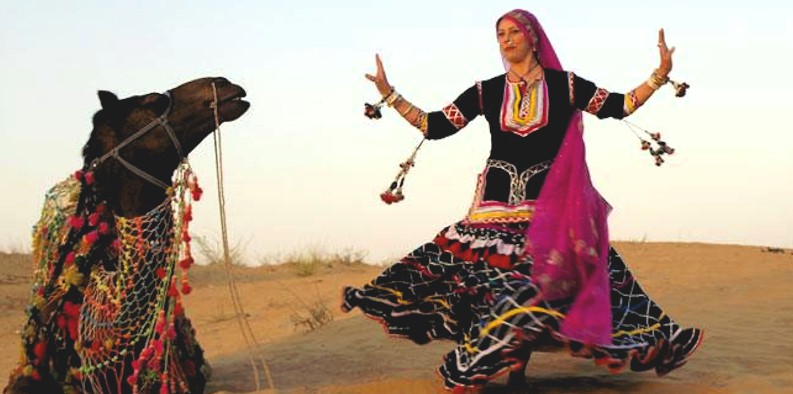
New Year’s Eve: Raksha Bandhan, the celebration commending the connection among family, is seen with extraordinary energy in Rajasthan. Sisters tie brilliant strings called “rakhi” on their siblings’ wrists, representing affection and assurance. A joyful atmosphere is created when families come together to give and receive blessings, sweets, and gifts.
Gangaur Celebration: Gangaur is a customary celebration that praises the goddess Gauri, an encapsulation of conjugal rapture and richness. Ladies dress in their best clothing, embellish themselves with complicated gems, and convey delightfully improved icons of the goddess during brilliant parades. The celebration includes customary moves, music, and ceremonies that exhibit Rajasthan’s social legacy.
Festival of Marwar: The Marwar Festival is a cultural celebration in Jodhpur that honors Rajasthan’s heroic tales and folklore. The festival features a wide range of traditional dance and music, including the well-known Marwari folk dance and songs of valor. The festivities also include horse polo matches, traditional arts and crafts exhibitions, and camel tattoo shows.
Bundi Utsav: The cultural festival known as Bundi Utsav is held in the town of Bundi for three days. It exhibits the rich history, craftsmanship, and culture of the area. The celebration highlights customary music and dance exhibitions, manikin shows, turban tying rivalries, and a terrific light show against the setting of the glorious Bundi Royal residence.
Pushkar Camel Fair: The Pushkar Camel Fair, held in the heavenly town of Pushkar, is a popular widespread development that draws in the two local people and travelers. It is one of a kind to combine a lively carnival with a livestock fair. Large number of camels, ponies, and dairy cattle are brought for exchanging, while social exhibitions, camel races, turban tying rivalries, and music shows engage guests.

Fair of Nagaur: The Nagaur Fair is one of the biggest dairy cattle fairs in Rajasthan and offers an enrapturing mix of animals exchanging, social exhibitions, and energizing occasions. Farmers, merchants, and tourists flock to the fair to witness the vibrant animal displays, folk music, and traditional sports like tug-of-war and camel races.
During the monsoon season, these festivals and cultural celebrations are a wonderful opportunity to experience Rajasthan’s vibrant traditions, artistic expressions, and joyful spirit. They offer a brief look into the social lavishness and warm neighborliness of the state, making it a genuinely paramount encounter for guests.
Conclusion
All in all, meeting Rajasthan during the rainstorm season offers an exceptional chance to observe the normal magnificence, experience energetic celebrations, and drench oneself in the rich social legacy of the district. However, it is essential to take certain precautions to guarantee a pleasant and risk-free journey. Really looking at weather patterns, conveying suitable dress and footwear, remaining hydrated, driving securely, being wary close to water bodies, remaining informed about nearby circumstances, and anticipating indoor exercises are fundamental stages to take. By following these precautionary measures, you can capitalize on your excursion to Rajasthan, enjoying the stunning scenes, partaking in social festivals, and making enduring recollections of your storm experience in the Place that is known for Rulers.
FAQs
What is the best time to visit Rajasthan?
During the winter months, from October to March, when the weather is pleasant and ideal for sightseeing, Rajasthan is at its best. However, the monsoon season, which lasts from July to September, also provides a one-of-a-kind experience with cultural festivals and lush vegetation.
What are the must-visit cities in Rajasthan?
Rajasthan is home to a few exceptional urban communities. The must-visit urban areas incorporate Jaipur, Udaipur, Jodhpur, Jaisalmer, Pushkar, and Bikaner. Lakes, forts, palaces, vibrant markets, and other attractions are all unique to each city.
What should I pack for a trip to Rajasthan?
When traveling to Rajasthan, it is best to bring clothing that is lightweight and breathable, especially in the hot summer months. Include comfortable footwear, sunscreen, sunglasses, a sun hat or scarf, a reusable water bottle, and comfortable sunglasses. Moreover, convey a light coat or cloak for cooler nights throughout the colder time of year season.
Is it safe to drink tap water in Rajasthan?
In general, it is advised not to drink tap water in Rajasthan. Drinking water that has been purified and is available in most hotels and restaurants is a good idea. Likewise, be wary while drinking crude leafy foods that might have been washed in faucet water.
What are the popular dishes to try in Rajasthan?
Rajasthan is known for its flavorful and rich cuisine. Dal Baati Churma, which is made of lentils, baked wheat balls, and sweet crushed wheat, Laal Maas, which is a spicy meat curry, Gatte ki Sabzi, which is made of gram flour dumplings in a spicy gravy, and Ker Sangri, a traditional Rajasthani pickle made of dried berries and beans, are some popular dishes to try. Make sure you try the traditional, cooling drink known as “lassi.”
Keep in mind, it’s consistently really smart to do some extra examination and talk with dependable sources or travel services for the most modern and precise data in regards to your particular itinerary items in Rajasthan.







